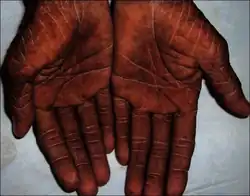Tripe palms
| Tripe palms | |
|---|---|
| Other names: Acquired pachydermatoglyphia[1] | |
.jpg.webp) | |
| Tripe palms | |
| Specialty | Dermatology |
| Symptoms | Thick ridged velvety palms[2] |
| Causes | Cancer[2] |
| Diagnostic method | Visualisation[2] |
| Differential diagnosis | Acromegaly, acrokeratosis paraneoplastica, hypertrophic osteoarthropathy, idiopathic hypertrophic osteoarthropathy, palmoplantar keratoderma, acropachy[1] |
| Treatment | Treat underlying cancer[3] |
| Frequency | Rare[3] |
Tripe palms, also known as acanthosis palmaris, is a medical sign characterized by thick ridged velvety palms, typically as part of a paraneoplastic syndrome.[2] It resembles the lining of the stomach of some animals (tripe).[1] Other signs that may be noted at the same time include most frequently acanthosis nigricans (AN), and less commonly finger clubbing and Leser-Trélat sign.[1]
How it occurs is unclear.[3] More than 90% of individuals with the sign have a cancer.[1][2] In some, both tripe palms and AN appear together before the cancer is diagnosed.[3] Lung cancer is more frequent if the tripe palms present alone, whereas cancer of the stomach is more frequent when AN is also present.[2] The sign has also been associated with bullous pemphigoid, psoriasis, and exfoliative dermatitis.[1] It is believed that growth factors secreted by cancer cells cause some skin cells to grow.[3]
Diagnosis is by its appearance and a biopsy is generally not helpful.[1] Other conditions that may appear similar include acromegaly, acrokeratosis paraneoplastica, hypertrophic osteoarthropathy, idiopathic hypertrophic osteoarthropathy, palmoplantar keratoderma, and acropachy.[1] The sign may improve with treatment of the underlying cancer.[3]
The sign is rare.[3] There are around 100 reported cases worldwide.[1] The term was first coined by Jacqueline Clarke in 1977.[4][5]
Signs and symptoms
See also
- List of cutaneous conditions associated with internal malignancy
References
- 1 2 3 4 5 6 7 8 9 "Tripe Palms - DermNet". dermnetnz.org. Archived from the original on 7 June 2023. Retrieved 1 August 2023.
- 1 2 3 4 5 6 James, William D.; Elston, Dirk; Treat, James R.; Rosenbach, Misha A.; Neuhaus, Isaac (2020). "24. Endocrine diseases". Andrews' Diseases of the Skin: Clinical Dermatology (13th ed.). Elsevier. p. 503. ISBN 978-0-323-54753-6. Archived from the original on 2023-08-02. Retrieved 2023-08-01.
- 1 2 3 4 5 6 7 Fonia, Athina; Baran, Robert (2021). "Cutaneous paraneoplastic syndromes with nail involvement". In Lipner, Shari (ed.). Nail Disorders: Diagnosis and Management, An Issue of Dermatologic Clinics. Elsevier. p. 179. ISBN 978-0-323-70924-8. Archived from the original on 2023-08-02. Retrieved 2023-08-01.
- ↑ Clarke, Jacqueline (June 1977). "Malignant acanthosis nigricans". Clinical and Experimental Dermatology. 2 (2): 167–170. doi:10.1111/j.1365-2230.1977.tb01561.x. PMID 884896. Archived from the original on 2023-08-02. Retrieved 2023-08-01.
- ↑ Niederhuber, John E. (1993). Current Therapy in Oncology. B.C. Decker. ISBN 978-1-55664-229-6. Archived from the original on 2023-08-02. Retrieved 2023-08-01.
